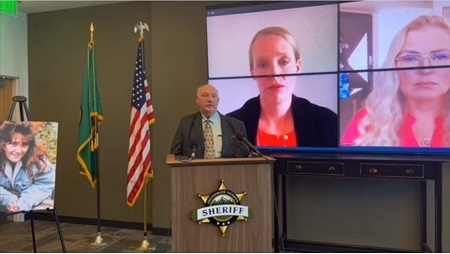
Detective Jim Scharf at the podium with Parabon's Ellen Greytak (right) and CeCe Moore (left) in the background. A photo of Michelle Koski sits to the right of Scharf. Credit: Snohomish County Sheriff’s Office.
In a very fitting end to a 45-year law enforcement career, Detective Jim Scharf of the Snohomish County Sheriff's Office and oft-partnered Parabon Nanolabs solved the 1990 sexual assault and murder of 17-year-old Michelle Koski with an extremely challenging DNA sample and a full year of genetic genealogy research.
On Aug. 25, 1990, Koski’s body was found about 15 miles from her home. There was scant evidence, but investigators did recover a mixed DNA sample—which they could not do anything with in 1990.
In 2005, Snohomish County Sheriff's Office formed a Cold Case Unit comprising of Scharf and now-retired detective David Heitzman. Koski’s case was the first the newly formed unit worked on. There was still no DNA match in CODIS, but over the next decade, several suspects were ruled out by obtaining their DNA. Still, the case remained cold.
Then, Scharf sent the crime scene samples to Parabon NanoLabs. The company’s bioinformatics department was able to deconvolute the mixture to ensure any genetic genealogy matches would include relatives of the suspect, not the victim.
With DNA data uploaded to Family Tree DNA and GEDmatch, genealogist Deb Stone, from Kin Forensics, worked for approximately one year building family trees. The genealogy ultimately led to the identification of two brothers of suspect Robert A. Brooks, who died in October 2016 from natural causes.
With the cooperation of the Snohomish County and King County Medical Examiner’s Offices and the Washington State Patrol Crime Lab, a blood sample was tested from Brooks that positively matched the DNA profile from the crime scene evidence.
According to investigators, Brooks was released from prison in April 1990, and went to live with a relative just a few blocks from where Koski resided. Scarf said they do not know exactly how or where Koski and Brooks crossed paths.
Koski’s case is the 24th to be solved by Scarf and the Cold Case Unit since its inception 17 years ago. The unit solved 9 cases in the first 13 years. In the past four years, they have solved 15 cases using investigative genetic genealogy (IGG).
“[Scharf] is a real trailblazer for genetic genealogy,” said CeCe Moore, Parabon’s chief genetic genealogist. “He was pushing for it even before the Golden State Killer was identified through IGG, which is generally recognized as the very first arrest made possible because of it. But [Scharf] was way ahead of the curve, trying to get work done on his cases before then. He is such an important part of the history of genetic genealogy and its success across the country.”
In fact, Scharf is the first cold case detective to solve a case with genetic genealogy. His 2018 investigation of the 1987 double murder of Jay Cook and Tanya Van Cuylenborg pulled Moore into the fold with law enforcement, as she previously only worked on adoption and unknown parentage mysteries.
Moore’s research on the case led Scharf to William Earl Talbott II, who became the second person ever identified and arrested with genetic genealogy—the Golden State Killer being the first only shortly before. Talbott’s case eventually made history as the first genetic genealogy case to result in a court conviction.
Scharf, Moore and Ellen Greytak, Parabon's Director of Bioinformatics, announced the close of Koski’s case during a press conference Thursday afternoon—the very last day of Scharf’s law enforcement career.
“This is a fitting finish to Detective Scharf’s distinguished career being the voice for those no longer able to speak for themselves. The epitome of a homicide detective, he has effectively set the bar very high for cold case investigations in the state of Washington,” said Heitzman, who was Scarf’s cold case partner from 2005 until his retirement in 2009. “Thousands of hours have gone into the Koski homicide investigation. The initial investigators laid a solid foundation with the proper collection and preservation of evidence, so that as the DNA technology improved years later, Cold Case Unit investigators working with the WSP Crime Lab, were able to have that evidence analyzed to ultimately identify [Koski’s] killer. It was a privilege to have been part of the team that worked on this case, and very rewarding to have it resolved.”